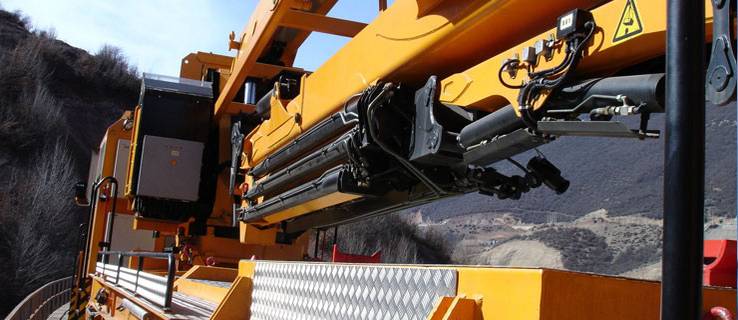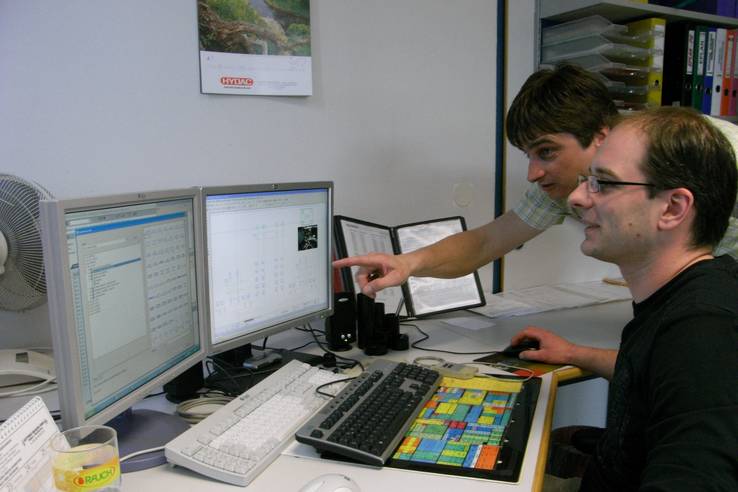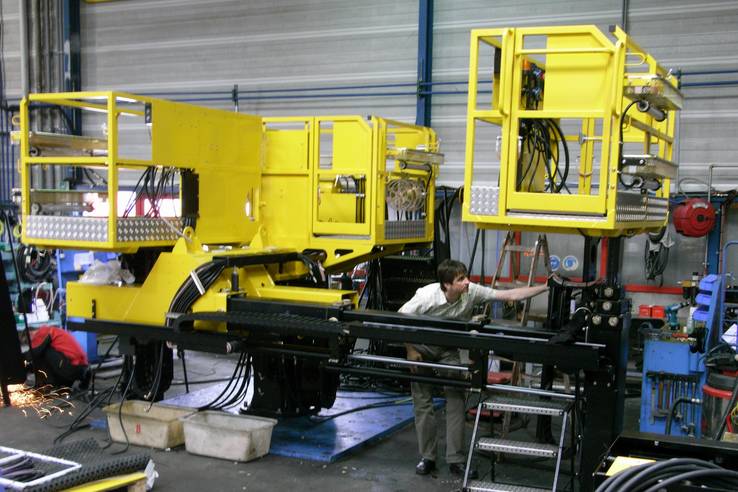Technology right on track
The maintenance of railroads and tracks is a complex task
The maintenance of railroads and tracks is a highly complex challenge. What used to be done by large numbers of persons in hard physical labor is nowadays done much more effectively by means of special vehicles for track construction. The maintenance of railroads and tracks is a highly complex challenge. These hydraulic-mechanical "marvels" are manufactured by PALFINGER - the systems of the EPLAN Platform are used to design both. Quiet conversation during breakfast in the diner. Past changing landscapes, through tunnels and over bridges. No sign of the enormous forces acting on the railroad system when an express train glides along at more than 200 km/h. Requiring the smooth interaction of all the components. Not only the vehicles, but also the track system has to be in a perfect state. The safety and trouble-free operation of the railroad depend on the precise levelness and trueness of the tracks up to the state of dams and bridges as well as the correctly tensioned overhead traction line. All of these have to be maintained perfectly all the time. In times when passenger trains are becoming ever faster and cargo trains weigh several hundred tons, the required maintenance and inspection also increases correspondingly. On the other hand, ever closer maintenance intervals provide little time to carry out this work without disrupting regular operation.
Innovations for rail maintenance
The maintenance of railroads and tracks is a complex task. Bringing people and material exactly where they are needed is a task solved by cranes, aerial work platforms and bridge inspection equipment as well as traction line positioners and manipulators as a core element of these maintenance vehicles. With railroads representing a particular challenge: Often the traction lines of a contact line are positioned over the tracks. The crane or the aerial work platform may not touch these, but rather have to bypass them by means of its geometry, even when, for example, a new mast is set next to the track in order to replace an older one. In the case of two-track lines technical measures have to be taken to ensure that the crane or work platform does not protrude into the opposite track or collide with the opposite train. At cambered curves the crane also has to place the load exactly on spot and finally it is often necessary to carry out work at walking speed in order to reduce track blocking to a minimum. In the case of bridge inspection equipment the enormous mobility and range of the extension arm may not result in a vehicle imbalance on the less than 1.5 m wide tracks.
Efficient electrical and fluid design
These hydraulic-mechanical marvels are designed by a team of eleven designers headed by the engineer Bernd Walch in the PALFINGER works in Köstendorf, in the vicinity of Salzburg. The mechanical part is modeled using a powerful 3D tool – hardly surprising in view of the enormous mobility of the systems – whereas EPLAN Electric P8 and EPLAN Fluid are used for the electrotechnical, pneumatic and hydraulic design. "Although the complexity in the electrotechnical part is not inconsiderable due to stability monitoring, height limiting and opposite-track blocking, the real challenge lies in the fluid power design", explains Bernd Walch. Not surprising since raising, rotating, slewing and last but not least the multiple telescopic extension of the extension arm is effected by means of four hydraulic cylinders in various sizes and designs. These are by the way also manufactured by PALFINGER themselves, making the company one of the largest manufacturers of hydraulic ´cylinders. Until 2001 the electrotechnical design was also carried out with the mechanical design program at PALFINGER, with the disadvantages entailed due to the lack of logic functions. "We started in electrotechnical and fluid design using EPLAN in 2002 with the then current system EPLAN 5. Since 2007 we have been working with the new software generation EPLAN Electric P8 and with EPLAN Fluid“, reports Bernd Walch who has been designing at PALFINGER for 15 years. "EPLAN was one of two systems on the short list", remembers Bernd Walch. . In addition to the numerous system advantages offered by EPLAN, the deciding factor was that a number of important PALFINGER customers were already satisfied EPLAN customers - an important factor with regard to data exchange. "Today we are pleased that we tool the right decision then. For we are working with a powerful system with excellent support, while the other product has meanwhile disappeared from the market."
Continuity and openness
The complexity of the lifting, loading and handling devices ensure that the possibilities offered by the design system are used to their full extent. "Thanks to the migration to the new EPLAN Electric P8, our system has reached an incomparable strength, since many advantages of EPLAN 21 were integrated with the previous EPLAN 5 version" says a pleased Bernd Walch. For EPLAN Electric P8 offers many additional opportunities for the automation and a decisive advantage: Based on the EPLAN Platform the system is coupled directly to EPLAN Fluid – both systems operate integratively on a uniform database. "Migration to the new system also required the hardware to be upgraded. However, the investment has already paid off through the increase in efficiency and the additional possibilities provided." In addition to the continuous control system documentation, the easy linking of the electrotechnical design with fluid power planning as well as the openness of the system are important for PALFINGER. "With an average of 50 schematic pages the electrotechnical part remains the most extensive, while we solve the greater technical challenges in fluid power design", says Bernd Walch. "The fact that a designer can be sure that the simple use of a symbol from another discipline will always result in the correct linkage is surely one of the greatest facilitations resulting from the use of the EPLAN Platform."
PALFINGER is a hoisting technology company operating internationally with almost 700 million Euro group turnover (2007) with its headquarters in the Austrian city of Salzburg. Established in 1932 as metalwork and repair workshop for agricultural trailers, tippers and vehicle bodies, PALFINGER manufactured its first crane in 1950 and developed into the market leader worldwide for lifting, loading and handling systems at the interfaces in the transportation chain. The well-established and best-known PALFINGER products are the truck-mounted hydraulic cranes produced in series since 1966, of which 150 different models are now manufactured and which have a market share of 30%. With the know-how gained from this field, PALFINGER started manufacturing products not only for road usage, but also specially for track vehicles, somewhat more than 20 years ago. This has developed into the PALFINGER RAILWAY division that currently manufactures about 250 systems per year and delivers them all over the world.






